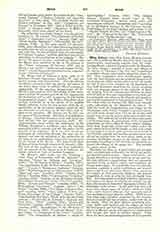

Mixe Indians (also MIJE, Latin, Mi-she), a mountain tribe in southern Mexico, noted for their extreme conservatism, constituting together with the neigh-bouring Zoque, a distinct linguistic stock, the Zoquean. The Mixe occupy a number of towns and villages in the district of Yautepec, Villa Alta, and Tehuantepec in southern Oaxaca and number altogether about 25,000. They maintained their independence against both the Aztec Empire and the powerful Zapotec with whom they are still at enmity and even yet can hardly be said to have been subdued by the Spaniards, as they hold themselves aloof from the whites, retaining their own language almost to the exclusion of Spanish, keeping their old customs and adhering to many of their ancient rites and superstitions even while giving ostensible obedience to the Church and manifesting a docile attachment to their resident priests. With the other tribes of Oaxaca, the Mixe were brought under subjection by the Spaniards in 1521-4. In 1526 the work of evangelization was begun by the Dominicans under Father Gonzalo Lucero and continued with them, shared after 1575 by the Jesuits until turned over to secular priests under later settled conditions. The work of conversion was slow and uncertain for many years, in consequence of the exceptional attachment of these tribes to their ancient religion. Idols were frequently discovered buried under the cross erected in front of the chapel, so that they might be worshipped in secret under pretense of devotion to the Christian symbol, and heathen sacrifices were even offered up secretly from the very altars, under an impression, intelligible enough to the Indian, that the sacredness attaching to the Christian environment enhanced the efficacy of the pagan rite. This prevails to a great extent today.
Physically the Mixe are of good height and strongly built, not handsome in features, but hardy and active, and notable burden carriers. Many wear beards. Although described in ancient times as savage and war-like and addicted to cannibalism, they are commonly regarded today as timid, stupid, and suspicious, although industrious. It is probable, however, that the apparent stupidity is rather indifference and studied reserve, and Starr, their most recent visitor, expresses his surprise at their industry, neatness, and general prosperity, in view of what he had previously been told. It is characteristic of their stubborn disposition that their roads almost invariably run straight up and down the mountain instead of zigzagging to lessen the difficulties of the ascent. In the same way they still keep their villages upon the heights, while the other tribes, under Spanish influence, have generally moved their settlements down into the valleys. Their houses vary from light thatched structures in the country districts to well-built log or adobe, roofed with tile, in the towns. They are good farmers, producing corn, sugar, coffee, and bananas, and the women are noted for their pottery and weaving arts, producing beautiful fabrics in silk and cotton, with interwoven animal and bird designs and dyed in fadeless colors. From Starr we have an interesting account of their present day customs and beliefs, including many pagan survivals, particularly bird and other animal sacrifices. Food is still buried with the dead and libations made to the earth, while offerings are still made secretly at heathen shrines and before idols hidden away in secret caves. One of these was discovered by the parish priest of their principal town a few years ago, and according to reliable testimony instances of cannibal sacrifice have occurred within living memory. Among their numerous dances is a dramatic performance founded upon the story of the Conquest, with characters representing Montezuma, Cortes, and Malinche.
The Mixe language is peculiarly harsh in sound and is spoken in several dialects. Its chief monument is the “Institution Cristiana, que contiene el Arte de la lengua Mije” of the Dominican Father Agustin Quintana (c. 1660-1734). It was published at Puebla in 1729 and reprinted at Oaxaca in 1891.
JAMES MOONEY

